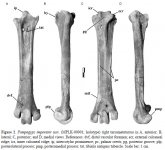Pampagyps imperator nov. gen. et sp.
Federico L. AGNOLIN, Federico BRISSÓN EGLI, Esteban SOIBELZON, Sergio G. RODRIGUEZ, Leopoldo H. SOIBELZON, Facundo IACONA & David PIAZZA, 2017
A new large Cathartidae from the quaternary of Argentina, with a review of the fossil record of condors in South America
Contribuciones Científicas del Museo Argentino de Ciencias Naturales “Bernardino Rivadavia” 7: 1-16
Free pdf:
https://www.researchgate.net/public...the_fossil_record_of_condors_in_South_America
Abstract:
The fossil record of condors in South America is relatively extensive. However, fossil specimens for the late Pleistocene of Argentina are scarce. Here, we report a new genus and species of a large sized cathartid of the condor lineage. The new taxon,
Pampagyps imperator nov. gen. et sp. is based on a right tarsometatarsus from the “Cantera Nicolás Vignogna III” fossiliferous locality, at Marcos Paz County, Buenos Aires Province, Argentina. The fossil was found in the middle levels of the outcrop assigned to the Lujanian Stage/Age (late Pleistocene). Its size is comparable to
Geronogyps and
Gymnogyps, being smaller than
Vultur. Its combination of characters is unique, allowing recognizing a new taxon. An overview of fossil cathartids from Argentine lowlands indicates the existence of several condors that are not closely related to the extant
Vultur gryphus. The presence of these large cathartids allows to review the fossil record of
V. gryphus. The latter taxon has been recorded in the Pliocene of Buenos Aires Province (Argentina), and the Pleistocene of Estado Plurinacional de Bolivia and Brazil. A review of the Pliocene specimens from Buenos Aires Province suggests that they belong to an unnamed form not closely related to
Vultur. Moreover, specimens from Bolivia are different from living
V. gryphus, indicating that they belong to the extinct species
“Sarcoramphus” patruus. Brazilian records are fragmentary and found near to the locality where the fossil form
Pleistovultur nevesi was described. Thus, we restrict the record of
V. gryphus to the late Pleistocene of Andean and Patagonian regions.
This paper is part of the proceedings of the 9th SAPE meeting in 2016 in Argentina
Enjoy,
Fred






